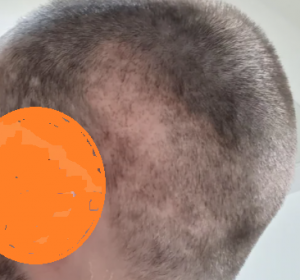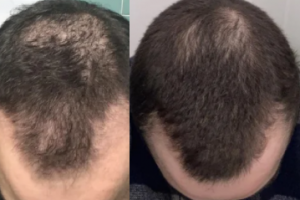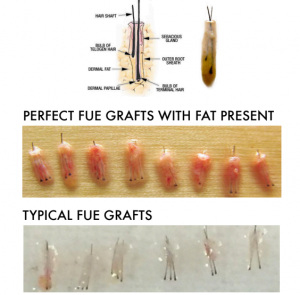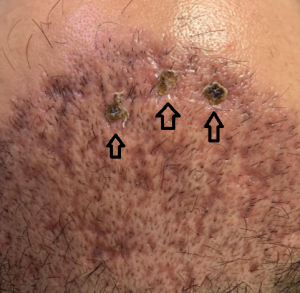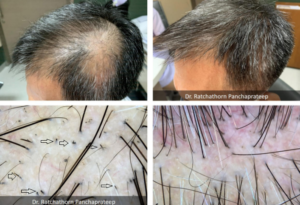This photo contains Follicular Units that were excised from the donor area using two different techniques. The graphic at the top identifies all of the elements of a single Follicular Unit. This particular follicular unit has two hairs, one is what I am calling a ‘telogen’ hair (shorter hair below the skin is either starting to grow or shrinking down (more likely). On the rows of Follicular Units (grafts), you can count the number of hairs in each graft. On row two, the grafts were removed using a punch with subdermal tumescence. Note here in row two, that the hairs are surrounded by fat, especially prominent at the bulbs on the bottom of the grafts. Row three shows Follicular Units excised with a different punch. These grafts do not have much fat at the bottom and the three follicular units on the right have no fat at the bottom at all. Because there is no fat to protect them from drying once they are removed, they can not be exposed to the air for more than a few seconds without a risk drying and death. If these three grafts are placed with forceps, they might likely be damaged as the operator will have to use the forceps to squeeze the grafts at the bulb, possibly damaging the grafts. Placement with implanters, solves this problem.
Im not a huge fan of this look, but I know people with no hair loss who shave the sides of their heads to the skin and then grow out the top a bit. I generally do more of a fade rather than complete shaving, but would consider this look if I don’t have a choice. I don’t know a ton about transplants because I am new to this, but I don’t see why someone couldn’t simply take all the donor hair they have and then put it up top. Other than money, I don’t know why this wouldn’t be a possibility. Combine SMP with FUE, doesn’t that make sense?
Good planning on the surgeon’s part allows the surgeon to estimate the donor supply and match it against the recipient needs. If there is not enough hair (a mathematical calculation), then SMP can be added as shown in this article I wrote: https://newhair.com/wp-content/uploads/2018/11/Combining_Follicular_Unit_Extraction_and_Scalp.98621.pdf
I’m looking at topical, how much is 0.1% fin to mg in tablet. Are there pros and cons to topical fin?
In the US at Costco, I was able to buy a year supply of generic finasteride for $30. Topical Liposomal Finasteride costs about $60/month. The limitations of the topical, is that it only works where you put it so if you are losing hair all over, then the amount of topical finasteride will increase significantly along with the costs.
This is a patient who has been picking at his hair for 20 years. Although a hair transplant can put normal hair back, it is a psychiatric problem because even if transplanted, this man will continue to pick and pull out his hairs. These hairs are shown as cut off by his fingernails by arrow and this is what makes the diagnosis for the physician. This man after psychiatric care and medications, grew his hair hair back without surgery.
Why are women wigs way more accepted by society and look way better and real than men wigs ?? It’s also much more expensive for a guy to wear a wig rather than a girl . And 90% of men systems look fake
Wigs are very common in African American women because if they have kinky hair, they can’t style it like the fashion models do. The same is for other women who can more easily through on wig for a night out rather than go to the salon to have their hair fixed up.
Men don’t have that luxury to change their hair on the ‘drop of a hat’ and when they wear a hair system, most men have their head shaved, with the wigs fixed on by glues so that they can’t just come off and switch a style.
https://onlinelibrary.wiley.com/doi/10.1111/jdv.17738
Conclusion: Topical finasteride significantly improves hair count compared to placebo and is well tolerated. Its effect is similar to that of oral finasteride, but with markedly lower systemic exposure and less impact on serum DHT concentrations.
What makes a hair transplant detectable. I know the freaks I see with those awful plugs, but today these are not done anymore so what must I look for when I am told that the transplant is not detectable.
There are many distinct reasons for detectability of a hair transplant.
(1) The first is clearly the harshness or the delicacy of the grafts that are placed. If they are not placed as God has grown them (natural groups of one, two, three or four hairs each) and they are not graded (singles in the frontal line only to create a transition zone between the forehead and the beginning of a hairline) then the presence of more than a one hair graft in the frontal hairline can be visually detectable as not soft. Natural looking transplants are soft in appearance.
(2) The rest of what makes hair transplant look like transplants are Location, Location and Location. If a hairline is placed too high, then even if they are put in as discussed (in #1 above) the location calls your attention to the obvious look that something is not right. I am sure that even with good distribution, if hairlines are not placed back in the normal position, they will look abnormal. The rest of the ‘Location’ metaphor relates to the distribution of the supply to the demand area. The doctor must recreate a normal looking pattern that is found in nature. It is Ok to be thin but not imbalanced. So the Location issue must be tied to a MASTER PLAN when a hair transplant is planned and implemented. The art here is tied to the experience of the physician group who can mimic what god has created.
Today, the large old plugs are rarely used (except for the few dinosaurs left from the old days still performing them), but there are still doctors using grafts that are not the natural occurring follicular units that god defined. They come in many names, including slot grafts, mugs, minigrafts or even micrografts that end up transplanting skin along with the hair and therefore creating an abnormal skin surface along with a non-natural occurring anatomy. Today’s Standard of Care is the Follicular Unit which naturally contained between 1-4 hairs each. Still the axiom remains: Let the buyer beware. I say, do your research and be sure that you are going to get what is represented to you. The most abused term in the hair restoration industry is ˜Totally Natural and Undetectable Results’.
Click here: nutrition in women with hair loss
It is always a question for doctors. Can our diets help our problems such as hair loss in women. This article does address this issue but the subject material remains unclear from an absolute scientific approach.
I want to inform you that after 7 months, I am still experiencing genital numbness, shrinkage and rely on cialis to achieve erection. Libido is almost completely gone. All after quitting Saw Palmetto, which I tool for a year. I’ve done excessive testing (urological, neurological, endocrinologist…) and everything turned out fine. Yet, I am suffering from these extreme side effects. I seem to be one of the unlucky ones who got hit with PFS because of Saw Palmetto, which I didn’t think was possible at all. I’d ask for help but I don’t think anyone can. I only hope this information might be helpful to you about the dangers of 5AR-i.
This is the second time I have heard about Saw Palmetto as a cause of PFS type symptoms. I never personally met these patients but connected over internet forums. See a urologist as there are many causes of your symptoms that may not be tied to the Saw Palmetto
I just decided to take a break from FIN (after 9 months of 1mg/day) and within 4 days of stopping my flaccid penis size has returned back to what it used to be and I am starting to get morning woods again ( I have not had one in forever) with good libido.
I really do not want to take this drug knowing how much it shrunk my penis while I was on it (when soft, erected penis looked about the same but maybe a tad bit thinner) but it helped preventing further hair loss so much smh..
I tried not to think about my penis while I was on it, but not getting morning wood and shrunk penis are definitely side effects, right? After a month break I am thinking of starting back with 1mg eod regimen and hoping I will not get any of these sides..
My last resort would be 0.25mg eod and if this still makes my penis look small and takes away my libido,, I might just give up using this drug.
When you have to trade your sex life for your hair, I tell patients that my advice is forget the hair and focus on your sex life. Hair transplants can always solve the hair loss problem without a sex drive sacrifice. For other hair loss medications, oral minoxidil works nicely without the sexual side effects of finasteride. Also, some men use liposomal topical finasteride which is powerful and stays mostly just where you apply it in the scalp and doesn’t go significantly systemic.
Hello Dr. Rassman I was wondering could you explain how the ink of smp will not fade if you decided to get a hair transplant after getting Scalp Micropigmentation
All permanent tattoo inks fade over time, especially if you expose them to sun, however, the hair transplant will not impact the SMP. We have found that 20% of our SMP patients will come in for a touch-up within 5 years of the SMP. See our website here: https://scalpmicropigmentation.com/
Page 112 of 1247

